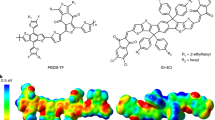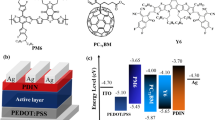Abstract
The application of organic photovoltaic (OPV) cells to drive off-grid microelectronic devices under indoor light has attracted broad attention. As organic semiconductors intrinsically have less ordered intermolecular packing than inorganic materials, the relatively larger energetic disorder is one of the main results that limit the photovoltaic efficiency of the OPV cells at low carrier density. Here, we optimize the alkyl chains of non-fullerene acceptors to get suppressed energetic disorder. We find the optimal acceptor DTz-R1 with the shortest alkyl chain has the strongest crystalline property and lowest energetic disorder. As a result, over 26% efficiency is recorded for the 1 cm2 OPV cells under a light-emitting diode illumination of 500 lux. We also fabricate a 100 cm2 cell device and get a PCE of 23.0%, which is an outstanding value for large-area OPV cells. These results suggest that modulation of the energetic disorder is of great importance for further improving the efficiency of OPV cells, especially for indoor applications.
Similar content being viewed by others
References
Brabec, C. J. Organic photovoltaics: technology and market. Sol. Energy Mater Sol. Cells 2004, 83, 273.
Søndergaard, R.; Hösel, M.; Angmo, D.; Larsen-Olsen, T. T.; Krebs, F. C. Roll-to-roll fabrication of polymer solar cells. Mater. Today 2012, 15, 36.
Heeger, A. J. 25th Anniversary article: bulk heterojunction solar cells: understanding the mechanism of operation. Adv. Mater. 2014, 26, 10.
Krebs, F. C. Fabrication and processing of polymer solar cells: A review of printing and coating techniques. Sol. Energy Mat. Sol. C 2009, 93, 394.
Cui, Y.; Xu, Y.; Yao, H.; Bi, P.; Hong, L.; Zhang, J.; Zu, Y.; Zhang, T.; Qin, J.; Ren, J.; Chen, Z.; He, C.; Hao, X.; Wei, Z.; Hou, J. Single-junction organic photovoltaic cell with 19% efficiency. Adv. Mater. 2021, 33, 2102420.
Zheng, Z.; Wang, J.; Bi, P.; Ren, J.; Wang, Y.; Yang, Y.; Liu, X.; Zhang, S.; Hou, J. Tandem organic solar cell with 20.2% efficiency. Joule 2022, 6, 171.
Chong, K.; Xu, X.; Meng, H.; Xue, J.; Yu, L.; Ma, W.; Peng, Q. Realizing 19.05% efficiency polymer solar cells by progressively improving charge extraction and suppressing charge recombination. Adv. Mater. 2022, 34, 2109516.
Yan, N.; Zhao, C.; You, S.; Zhang, Y.; Li, W. Recent progress of thin-film photovoltaics for indoor application. Chinese Chem. Lett. 2020, 31, 643.
Russo, J.; Ray, W.; Litz, M. S. Low light illumination study on commercially available homojunction photovoltaic cells. Appl. Energy 2017, 191, 10.
Cui, Y.; Wang, Y.; Bergqvist, J.; Yao, H.; Xu, Y.; Gao, B.; Yang, C.; Zhang, S.; Inganäs, O.; Gao, F.; Hou, J. Wide-gap non-fullerene acceptor enabling high-performance organic photovoltaic cells for indoor applications. Nat. Energy 2019, 4, 768.
Mathews, I.; Kantareddy, S. N.; Buonassisi, T.; Peters, I. M. Technology and market perspective for indoor photovoltaic cells. Joule 2019, 3, 1415.
Bai, F.; Zhang, J.; Zeng, A.; Zhao, H.; Duan, K.; Yu, H.; Cheng, K.; Chai, G.; Chen, Y.; Liang, J.; Ma, W.; Yan, H. A highly crystalline non-fullerene acceptor enabling efficient indoor organic photovoltaics with high EQE and fill factor. Joule 2021, 5, 1231.
Ding, Z.; Zhao, R.; Yu, Y.; Liu, J. All-polymer indoor photovoltaics with high open-circuit voltage. J. Mater. Chem. A 2019, 7, 26533.
Xie, L.; Song, W.; Ge, J.; Tang, B.; Zhang, X.; Wu, T.; Ge, Z. Recent progress of organic photovoltaics for indoor energy harvesting. Nano Energy 2021, 82, 105770.
Mainville, M.; Leclerc, M. Recent progress on indoor organic photovoltaics: from molecular design to production scale. ACS Energy Lett. 2020, 5, 1186.
Li, B.; Hou, B.; Amaratunga, G. A. J. Indoor photovoltaics, the next big trend in solution-processed solar cells. InfoMat 2021, 3, 445.
Liu, S.; Yuan, J.; Deng, W.; Luo, M.; Xie, Y.; Liang, Q.; Zou, Y.; He, Z.; Wu, H.; Cao, Y. High-efficiency organic solar cells with low nonradiative recombination loss and low energetic disorder. Nat. Photon. 2020, 14, 300.
Xiao, B.; Calado, P.; MacKenzie, R. C. I.; Kirchartz, T.; Yan, J.; Nelson, J. Relationship between fill factor and light intensity in solar cells based on organic disordered semiconductors: the role of tail states. Phys. Rev. Appl. 2020, 14, 024034.
Kupgan, G.; Chen, X. K.; Brédas, J. L. Low energetic disorder in small-molecule non-fullerene electron acceptors. ACS Mater. Lett. 2019, 1, 350.
Gupta, V.; Kyaw, A. K.; Wang, D. H.; Chand, S.; Bazan, G. C.; Heeger, A. J. Barium: an efficient cathode layer for bulk-heterojunction solar cells. Sci. Rep. 2013, 3, 1965.
Athanasopoulos, S.; Bassler, H.; Kohler, A. Disorder vs delocalization: which is more advantageous for high-efficiency organic solar cells. J Phys Chem Lett 2019, 10, 7107.
Hawks, S. A.; Deledalle, F.; Yao, J.; Rebois, D. G.; Li, G.; Nelson, J.; Yang, Y.; Kirchartz, T.; Durrant, J. R. Relating recombination, density of states, and device performance in an efficient polymer:fullerene organic solar cell Blend. Adv. Energy Mater. 2013, 3, 1201.
Lv, J.; Feng, Y.; Fu, J.; Gao, J.; Singh, R.; Kumar, M.; Kim, M.; Tang, H.; Lu, S.; Zhang, W.; McCulloch, I.; Li, J.; Kan, Z. Energetic disorder and activation energy in efficient ternary organic solar cells with nonfullerene acceptor Eh-IDTBR as the third component. Solar RRL 2019, 4, 1900403.
Tang, A.; Xiao, B.; Wang, Y.; Gao, F.; Tajima, K.; Bin, H.; Zhang, Z G.; Li, Y.; Wei, Z.; Zhou, E. Simultaneously achieved high open-circuit voltage and efficient charge generation by fine-tuning chargetransfer driving force in nonfullerene polymer solar cells. Adv. Funct. Mater. 2017, 28, 1704507.
Xu, Y.; Cui, Y.; Yao, H.; Zhang, T.; Zhang, J.; Ma, L.; Wang, J.; Wei, Z.; Hou, J. A New conjugated polymer that enables the integration of photovoltaic and light-emitting functions in one device. Adv. Mater. 2021, 33, 2101090.
Menke, S. M.; Cheminal, A.; Conaghan, P.; Ran, N. A.; Greehnam, N. C.; Bazan, G. C.; Nguyen, T. Q.; Rao, A.; Friend, R. H. Order enables efficient electron-hole separation at an organic heterojunction with a small energy loss. Nat. Commun. 2018, 9, 277.
Beuel, S.; Hartnagel, P.; Kirchartz, T. The influence of photo-induced space charge and energetic disorder on the indoor and outdoor performance of organic solar cells. Adv. Theor. Simul. 2021, 4, 2000319.
Grimme, S.; Antony, J.; Ehrlich, S.; Krieg, H. A consistent and accurate ab initio parametrization of density functional dispersion correction (DFT-D) for the 94 elements H-Pu. J. Chem. Phys. 2010, 132, 154104.
Antony, A.; Murali, K. V.; Manoj, R.; Jayaraj, M. K. The effect of the pH value on the growth and properties of chemical-bath-deposited ZnS thin films. Mater. Chem. Phys. 2005, 90, 106.
Göhler, C.; Wagenpfahl, A.; Deibel, C. Nongeminate recombination in organic solar cells. Adv. Electron. Mater. 2018, 4, 1700505.
Yuan, J.; Zhang, C.; Chen, H.; Zhu, C.; Cheung, S. H.; Qiu, B.; Cai, F.; Wei, Q.; Liu, W.; Yin, H.; Zhang, R.; Zhang, J.; Liu, Y.; Zhang, H.; Liu, W.; Peng, H.; Yang, J.; Meng, L.; Gao, F.; So, S.; Li, Y.; Zou, Y. Understanding energetic disorder in electron-deficient-core-based non-fullerene solar cells. Sci. China Chem. 2020, 63, 1159.
Zhang, M.; Zhu, L.; Hao, T.; Zhou, G.; Qiu, C.; Zhao, Z.; Hartmann, N.; Xiao, B.; Zou, Y.; Feng, W.; Zhu, H.; Zhang, M.; Zhang, Y.; Li, Y.; Russell, T. P.; Liu, F. High-efficiency organic photovoltaics using eutectic acceptor fibrils to achieve current amplification. Adv. Mater. 2021, 33, 2007177.
Zhong, Y.; Trinh, M. T.; Chen, R.; Purdum, G. E.; Khlyabich, P. P.; Sezen, M.; Oh, S.; Zhu, H.; Fowler, B.; Zhang, B.; Wang, W.; Nam, C. Y.; Sfeir, M. Y.; Black, C. T.; Steigerwald, M. L.; Loo, Y. L.; Ng, F.; Zhu, X. Y.; Nuckolls, C. Molecular helices as electron acceptors in highperformance bulk heterojunction solar cells. Nat. Commun. 2015, 6, 8242.
Wang, R.; Zhang, C.; Li, Q.; Zhang, Z.; Wang, X.; Xiao, M. Charge separation from an intra-moiety intermediate state in the highperformance PM6:Y6 organic photovoltaic blend. J. Am. Chem. Soc. 2020, 142, 12751.
Kaake, L. G.; Moses, D.; Heeger, A. J. Coherence and uncertainty in nanostructured organic photovoltaics. J. Phys. Chem. Lett. 2013, 4, 2264.
Gao, J.; Wang, J.; Xu, C.; Hu, Z.; Ma, X.; Zhang, X.; Niu, L.; Zhang, J.; Zhang, F. A Critical review on efficient thick-film organic solar cells. Solar RRL 2020, 4, 2000364.
Zhang, Y.; Feng, H.; Meng, L.; Wang, Y.; Chang, M.; Li, S.; Guo, Z.; Li, C.; Zheng, N.; Xie, Z.; Wan, X.; Chen, Y. High performance thick-film nonfullerene organic solar cells with efficiency over 10% and active layer thickness of 600 nm. Adv. Energy Mater. 2019, 9, 1902688.
Chaturvedi, N.; Gasparini, N.; Corzo, D.; Bertrandie, J.; Wehbe, N.; Troughton, J.; Baran, D. All slot-die coated non-fullerene organic solar cells with PCE 11%. Adv. Funct. Mater. 2021, 31, 2009996.
Wang, G.; Adil, M. A.; Zhang, J.; Wei, Z. Large-area organic solar cells: material requirements, modular designs, and printing methods. Adv. Mater. 2019, 31, 1805089.
Sun, Y.; Liu, T.; Kan, Y.; Gao, K.; Tang, B.; Li, Y. Flexible organic solar cells: progress and challenges. Small Sci. 2021, 1, 2100001.
Distler, A.; Brabec, C. J.; Egelhaaf, H. J. Organic photovoltaic modules with new world record efficiencies. Prog. Photovolt. Res. Appl. 2020, 29, 24–31.
Dong, X.; Jiang, Y.; Sun, L.; Qin, F.; Zhou, X.; Lu, X.; Wang, W.; Zhou, Y. Large-area organic solar modules with efficiency over 14%. Adv. Funct. Mater. 2021, 32, 2110209.
Acknowledgments
This work was financially supported by the National Natural Science Foundation of China (Nos. 52003275, 22075301, 22122905 and 52120105005). J. H. Hou was supported by the Key Research Program of the Chinese Academy of Sciences (No. XDPB13) and the Bureau of International Cooperation Chinese Academy of Sciences (No. 121111KYSB20200043).
Author information
Authors and Affiliations
Corresponding authors
Additional information
Notes
The authors declare no competing financial interest.
Electronic Supplementary Information
Rights and permissions
About this article
Cite this article
Cui, Y., Yao, HF., Xu, Y. et al. 100 cm2 Organic Photovoltaic Cells with 23% Efficiency under Indoor Illumination. Chin J Polym Sci 40, 979–988 (2022). https://doi.org/10.1007/s10118-022-2761-x
Received:
Accepted:
Published:
Issue Date:
DOI: https://doi.org/10.1007/s10118-022-2761-x




